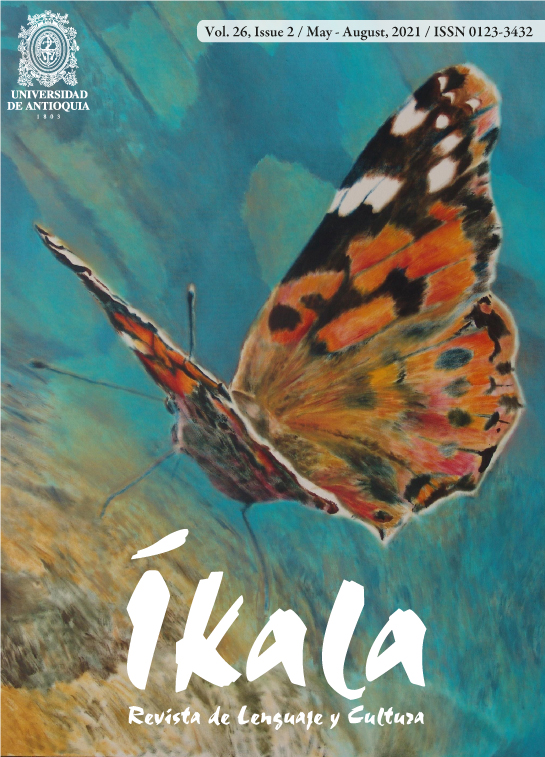An Analysis of the Hashtag #MeQuedoEnCasa: Digital Conversations in Twitter® Amid the Emergency Produced by COVID-19
DOI:
https://doi.org/10.17533/udea.ikala.v26n2a08Schlagworte:
covid-19, framing theory, linguistic analysis, social media, appraisal theory, Twitter®, digital conversationsAbstract
The covid-19 sanitary crisis came along isolation measures, among which was the lockdown that triggered multiple responses in social media. This article aims to examine digital discussions that took place through the hashtag #MeQuedoEnCasa (Spanish for “I’m Staying Home”), between the 20th and 27th of March 2020. The study is set around a mixed methodology in which social media mining techniques are combined with qualitative strategies, inherent to discourse analysis. From a theoretical point of view, we draw on Framing and Appraisal theories. Our results point to a positive framing of the lockdown through semiotic traits at different levels: lexical, semantic and pragmatic. The most influential accounts bent their discursive production towards the positive polarity. The empirical analysis allows us to conclude that the discursive framework of this digital conversation combines two semantic axes (community and health), two enunciative axes (here and now) and one emotional axis, which implies that hashtags such as #MeQuedoEnCasa works as signs of social identity, enunciative indexing marks, and instruments to promote individual responsibility from positive values.
Downloads
Literaturhinweise
Acosta, M. y Nevache, C. (2020). La conversación digital en torno al hashtag #RespetoAlDolorDeMadre en Panamá. Dígitos: Revista de Comunicación Digital, (6), 13-30. https://doi.org/10.7203/rd.v1i6.171
Ardèvol-Abreu, A. (2015). Framing o teoría del encuadre en comunicación. Orígenes, desarrollo y panorama actual en España. Revista Latina de Comunicación Social, (70), 423-450. https://doi.org/10.4185/RLCS-2015-1053
Arroyas Langa, E., Martínez Martínez, H. y Berná, C. (2018). Twitter como espacio alternativo a la esfera política institucional. Análisis retórico de las estrategias discursivas de Podemos durante la moción de censura contra Rajoy. En J. Segarra- Saavedra, T. Hidalgo-Marí y R. Rodríguez-Ferrándiz (Coords.), Actas de las Jornadas Científicas Internacionales sobre Análisis del discurso en un entorno transmedia (pp. 85-94). Universidad de Alicante, Alicante. https://doi.org/10.14198/MEDCOM/2017/11_cmd
Bai, Q., Dan, Q., Mu, Z. y Yang, M. (2019). A systematic review of emoji: Current research and future perspectives. Frontiers in Psychology, 10, 2221. https://doi.org/10.3389/fpsyg.2019.02221
Cantamutto, L., Vela Delfa, C. y Boisselier, L. (2015), Comunicación Digital : Corpus del Español (CoDiCE). http://codice.aplicacionesonline.com.ar/
Cautín-Epifani, V. (2015). Poder virtual y formas de tratamiento en el discurso mediado por computadora: exploración en una red comunicativa virtual. Forma y Función, 28(1), 55-78. https://doi.org/10.15446/fyf.v28n1.51971
Danesi, M. (2016). The semiotics of emoji. The rise of visual language in the age of the internet. Bloomsbury Publishing.
Entman, R. (1993). Framing: Toward clarification of a fractured paradigm. Journal of Communication, 43(4), 51-58. https://doi.org/10.1111/j.1460-2466.1993.tb01304.x
Entman, R. (2008). Media framing biases and political power: Explaining slant in news of Campaign 2008. Journalism, 11(4), 389-408. https://doi.org/10.1177/1464884910367587
Epsilon Technologies (2020). Informe gran consumo de redes durante la crisis de covid-19. https://www.epsilontec.com/clickfunnels/
Gallardo Paúls, B. (2014). Usos políticos del lenguaje. Un discurso paradójico. Anthropos.
Kaplan, N. (2004). Nuevos desarrollos en el estudio de la evaluación en el lenguaje: la teoría de la valoración. Boletín de Lingüística, 22, 52-78.
Larrondo, A., Morales-i-Gras, J. y Orbegozo-Terradillos, J. (2019). Feminist hashtag activism in Spain: Measuring the degree of politicisation of online discourse on #YoSíTeCreo, #HermanaYoSíTeCreo, #Cuéntalo y #NoEstásSola. Comunication & Society, 32(4), 207-221. https://doi.org/10.15581/003.32.4.207-221
McCombs, M. (2006). Estableciendo la agenda. El impacto de los medios en la opinión pública y en el conocimiento. Paidós.
Martin, J. R. y White, P. R. (2003). The language of evaluation. Palgrave Macmillan.
Molpeceres Arnáiz, S. y Filardo Llamas, L. (2020). Llamamientos feministas en Twitter: ideología, identidad colectiva y reenmarcado de símbolos en la huelga del 8M y la manifestación contra la sentencia de “La Manada”. Dígitos: Revista de Comunicación Digital, (6), 55-78. https://doi.org/10.7203/rd.v1i6.181
Moreno Ortiz, A. (2019). Mi opinión cuenta: la expresión del sentimiento en la red. En Comunicación mediada por ordenador: la lengua, el discurso y la imagen (pp. 38-74). Cátedra.
Moscovici, S. (1961). El psicoanálisis, su imagen y su público. Huemul.
Moscovici, S. (1998). Las representaciones sociales y la comunicación pragmática. Polis, 1(2), 205-222.
Pérez-Dasilva, J. A., K. Meso-Ayerdi y T. Mendiguren-Galdospín. (2020). Fake news y coronavirus: detección de los principales actores y tendencias a través del análisis de las conversaciones en Twitter. El profesional de la información, 29(3) e290308. http://www.elprofesionaldelainformacion.com/contenidos/2020/may/perez-meso-mendiguren.pdf
Prada, M., Rodrigues, D. L., Garrido, M. V., Lopes, D., Cavalheiro, B. y Gaspar, R. (2018). Motives, frequency and attitudes toward emoji and emoticon use. Telematics and Informatics, 35(7), 1925-1934. https://doi.org/10.1016/j.tele.2018.06.005
República Argentina, Boletín oficial (2020). Decreto 297/2020. Aislamiento social preventivo y obligatorio. 20 de marzo de 2020. https://www.boletinoficial.gob.ar/detalleAviso/primera/227042/20200320
Tajfel, H. (1981). Human groups & social categories. Studies in social psychilogy. Cambridge University Press.
Van Gorp, B. (2007). The constructionist approach to framing: Bringing culture back. Journal of Communication, 57(1), 60-78. https://doi.org/10.1111/j.0021-9916.2007.00329.x.
Vela, C. y Cantamutto, L. (2015). Problemas de recogida y fijación de muestras de discurso digital. Chimera, Romance Corpora and Linguistics Studies, 2, 131-155.
White, P. (2004). The Appraisal website: The language of attitude, arguability and interpersonal positioning. https://www.grammatics.com/appraisal/
Yus, F. (2014). Not all emoticons are created equal. Linguagem em (Dis) curso, 14(3), 511-529. http://dx.doi.org/10.1590/1982-4017-140304-0414
Zappavigna, M. (2011). Ambient affiliation: A linguistic perspective on Twitter. New Media & Society, 13(5), 788-806. http://dx.doi.org/10.1177/1461444810385097
Zeifer, B. (2020). El hashtag contestatario: cuando los hashtag tienen efectos políticos. Dígitos: Revista de Comunicación Digital, (6), 101-118. https://doi.org/10.7203/rd.v1i6.178
Veröffentlicht
Zitationsvorschlag
Lizenz
Copyright (c) 2021 Íkala

Dieses Werk steht unter der Lizenz Creative Commons Namensnennung - Nicht-kommerziell - Weitergabe unter gleichen Bedingungen 4.0 International.












